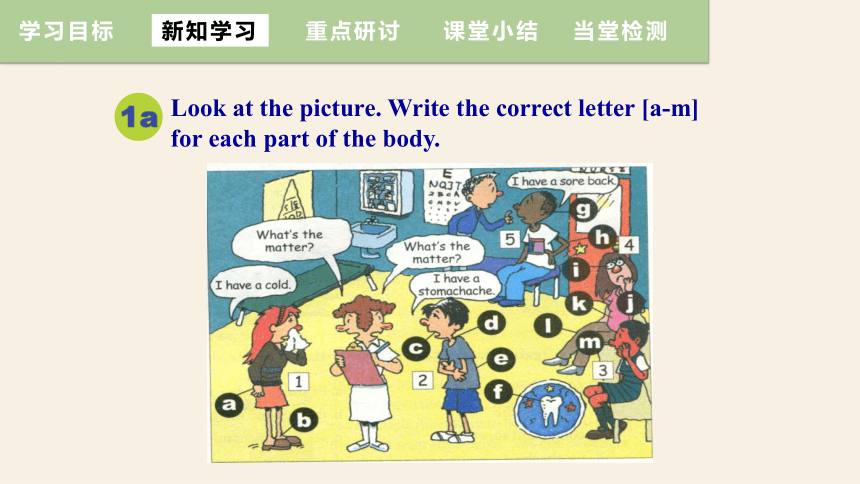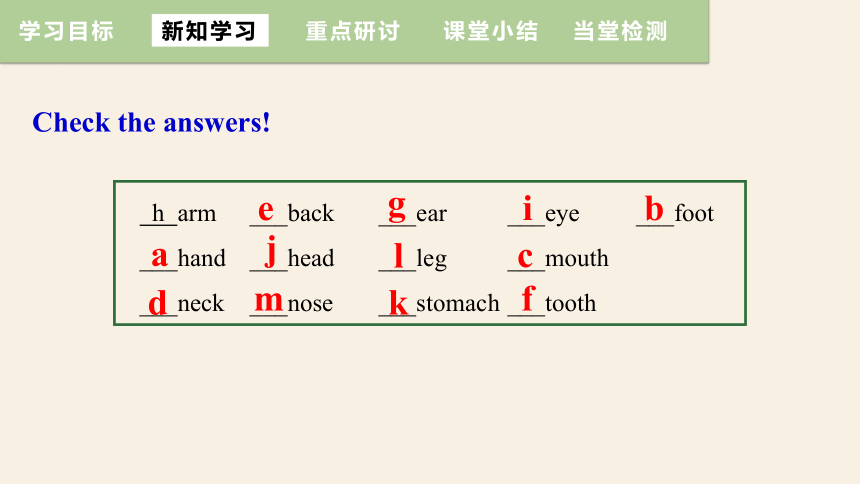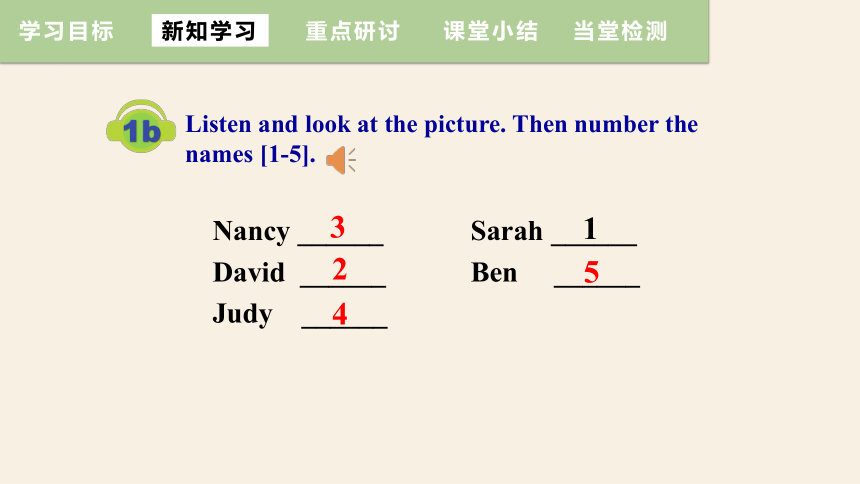Unit 1 What's the matter? Section A (1a~2d) 课件(共28张PPT,内嵌音视频) 2023-2024学年人教版英语八年级下册
文档属性
| 名称 | Unit 1 What's the matter? Section A (1a~2d) 课件(共28张PPT,内嵌音视频) 2023-2024学年人教版英语八年级下册 |  | |
| 格式 | pptx | ||
| 文件大小 | 42.0MB | ||
| 资源类型 | 教案 | ||
| 版本资源 | 人教新目标(Go for it)版 | ||
| 科目 | 英语 | ||
| 更新时间 | 2023-12-27 14:42:44 | ||
图片预览









文档简介
(共28张PPT)
Unit 1
What's the matter
Section A (1a~2d)
新
课
导
入
Let's enjoy a video
Language Goal
新知学习
课堂小结
当堂检测
学习目标
重点研讨
1.能熟悉并正确运用本课时的重点单词和短语
2.能说出表示身体部位的单词
3.能用英语询问及谈论自己或他人的病情
新知学习
课堂小结
当堂检测
学习目标
重点研讨
1a
Look at the picture. Write the correct letter [a-m]
for each part of the body.
新知学习
课堂小结
当堂检测
学习目标
重点研讨
h arm ___back ___ear ___eye ___foot
___hand ___head ___leg ___mouth
___neck ___nose ___stomach ___tooth
Check the answers!
e
g
i
b
a
j
l
c
d
m
k
f
新知学习
课堂小结
当堂检测
学习目标
重点研讨
Listen and look at the picture. Then number the
names [1-5].
Nancy ______ Sarah ______
David ______ Ben ______
Judy ______
1
3
2
5
4
1b
新知学习
课堂小结
当堂检测
学习目标
重点研讨
Listen and find out what’s the matter.
Conversation 1
Nurse: You don’t look well. What’s the
matter, Sarah
Sarah: I ___________.
Conversation 2
Nurse: What’s the matter, David
David : I _____________________.
have a cold
have a stomachache
新知学习
课堂小结
当堂检测
学习目标
重点研讨
Conversation 3
Nurse: What’s the matter, Ben
Ben : I _____________________.
Conversation 4
Nurse: What’s the matter, Nancy
Nancy : I _______________.
Conversation 5
Nurse: What’s the matter, Judy
Judy : I ________________.
have a sore back
have a toothache
have a sore throat
新知学习
课堂小结
当堂检测
学习目标
重点研讨
Look at the picture. What are the students’
problems Make conversations.
1c
A: What’s the matter with Judy
B: She talked too much yesterday and didn’t drink
enough water. She has a very sore throat now.
新知学习
课堂小结
当堂检测
学习目标
重点研讨
2a
Listen and number the pictures [1-5]in the order
you hear them.
1
2
3
4
5
新知学习
课堂小结
当堂检测
学习目标
重点研讨
Listen again. Match the problems with the advice.
2b
1.fever a. lie down and rest
2.stomachache b. drink some hot tea with honey
3. cough and sore throat c. see a dentist and get an X-ray
4.toothache d. take your temperature
5.cut myself e. put some medicine on it
新知学习
课堂小结
当堂检测
学习目标
重点研讨
Listen again. Then fill in the blanks.
You should____________
______________________
I have a cough and
sore throat
drink some
hot tea with honey.
新知学习
课堂小结
当堂检测
学习目标
重点研讨
You should _________
___________________
I have a toothache.
see a dentist
and get an X-ray.
新知学习
课堂小结
当堂检测
学习目标
重点研讨
I have a stomachache.
lie down
and rest
You should _________
__________.
新知学习
课堂小结
当堂检测
学习目标
重点研讨
I have a fever.
take your
temperature.
You should ___________
____________
新知学习
课堂小结
当堂检测
学习目标
重点研讨
I cut myself by accident.
You should ___________
____________________.
put some
medicine on it.
新知学习
课堂小结
当堂检测
学习目标
重点研讨
Role Play
Imagine you are the school doctor. A few students have health problems. Role-play a conversation between the doctor and the students.
新知学习
课堂小结
当堂检测
学习目标
重点研讨
2d
Read the conversation and fill in the blanks.
Mandy: Lisa, are you OK
Lisa: I and I can’t move my neck.
Should I ____________________
Mandy: No, it doesn’t sound like you _______________ What
did you do
Lisa: I played computer games all the weekend.
have a headache
What should I do
take my temperature
have a fever
on the weekend
新知学习
课堂小结
当堂检测
学习目标
重点研讨
Mandy: That’s probably why. You ____________________
away from the computer.
Lisa: Yeah, I think I sat in the same way for too long without moving.
Mandy: I think you should and rest. If your head and neck
still hurt tomorrow, then go to a doctor.
Lisa: OK. Thanks, Mandy.
need to take breaks
lie down
新知学习
课堂小结
当堂检测
学习目标
重点研讨
Language points
1. What’s the matter
这是询问病人病情时最常用的问句, 意思是“怎么了 ”
其后通常与介词with连用。类似的问句还有:
What’s wrong What’s wrong with you
What’s your trouble
What’s the trouble with you
What’s up
新知学习
课堂小结
当堂检测
学习目标
重点研讨
1) matter n.问题, 麻烦, 事件, 通常与介词 “with”连用。
2) wrong 是形容词, 前面没有“the”; matter和trouble都
是名词, 前面应有“the”, trouble前还可以用形容词性
的物主代词。
What’s your trouble, young man
年轻人, 你怎么了
新知学习
课堂小结
当堂检测
学习目标
重点研讨
2. I have a sore throat.
1) have vt. 患(得)病, (不用于进行时态)
He had a bad cold last week. 他上周患了重感冒。
She often has a stomachache. 她常胃(肚子)疼。
一般情况下用have+a+n. 表示患了某种疾病。
如:
have a cough 咳嗽
have a cold 感冒
新知学习
课堂小结
当堂检测
学习目标
重点研讨
2) sore“痛, 疼”, 通常指因发炎引起的肌肉疼, 在表示身
体的某部位疼痛时,常置于部位名词前。
ache常指持续性的疼痛, 它常与身体部位的名词构成
复合词,
如: headache头痛, backache背疼等。
新知学习
课堂小结
当堂检测
学习目标
重点研讨
3. have a cold
伤风, 感冒,是固定词组, 表示身体不适的常用词组还有:
牙疼 have a toothache
胃疼 have a stomachache
发烧 have a fever
新知学习
课堂小结
当堂检测
学习目标
重点研讨
4. lie down and rest
lie down 躺下
Don’t lie down on the ground. 不要躺在地上。
与down有关的词组:
sit down 坐下 come down 下来
get down 下车 write down 写下, 记下
新知学习
课堂小结
当堂检测
学习目标
重点研讨
5. hot tea with honey
1) hot adj. 热的
2) with 介词, 意思是“ 有, 用, 同……,由于, 和……一
致, 赞成, 关于”, 此句中是 “有, 带有……”的意思。
如: 有四个口袋的外套
a coat with four pockets
新知学习
课堂小结
当堂检测
学习目标
重点研讨
询问他人的病情我们通常用句型:
_______________________
类似的句型还有:
_______________________
_______________________
_______________________
_______________________
_______________________
表示人身体部位的单词:
______________________,
______________________,
______________________,
______________________,
______________________.
arm back ear eye foot hand head leg mouth neck nose stomach tooth
What’s the matter
What’s wrong
Unit 1
Section A (1a~2d)
What’s your trouble
What’s up
What’s wrong with you
What’s the trouble with you
新知学习
课堂小结
当堂检测
学习目标
重点研讨
根据括号中的汉语提示写单词, 完成句子。
1. I didn’t go to school yesterday, because I had a bad ________(感冒).
2. My _______(背部) is a little sore.
3. Please open your _________(嘴).
4. There is a ring around the dog’s __________(脖子).
5. I need to ________(休息) for an hour.
cold
back
mouth
neck
rest
Unit 1
What's the matter
Section A (1a~2d)
新
课
导
入
Let's enjoy a video
Language Goal
新知学习
课堂小结
当堂检测
学习目标
重点研讨
1.能熟悉并正确运用本课时的重点单词和短语
2.能说出表示身体部位的单词
3.能用英语询问及谈论自己或他人的病情
新知学习
课堂小结
当堂检测
学习目标
重点研讨
1a
Look at the picture. Write the correct letter [a-m]
for each part of the body.
新知学习
课堂小结
当堂检测
学习目标
重点研讨
h arm ___back ___ear ___eye ___foot
___hand ___head ___leg ___mouth
___neck ___nose ___stomach ___tooth
Check the answers!
e
g
i
b
a
j
l
c
d
m
k
f
新知学习
课堂小结
当堂检测
学习目标
重点研讨
Listen and look at the picture. Then number the
names [1-5].
Nancy ______ Sarah ______
David ______ Ben ______
Judy ______
1
3
2
5
4
1b
新知学习
课堂小结
当堂检测
学习目标
重点研讨
Listen and find out what’s the matter.
Conversation 1
Nurse: You don’t look well. What’s the
matter, Sarah
Sarah: I ___________.
Conversation 2
Nurse: What’s the matter, David
David : I _____________________.
have a cold
have a stomachache
新知学习
课堂小结
当堂检测
学习目标
重点研讨
Conversation 3
Nurse: What’s the matter, Ben
Ben : I _____________________.
Conversation 4
Nurse: What’s the matter, Nancy
Nancy : I _______________.
Conversation 5
Nurse: What’s the matter, Judy
Judy : I ________________.
have a sore back
have a toothache
have a sore throat
新知学习
课堂小结
当堂检测
学习目标
重点研讨
Look at the picture. What are the students’
problems Make conversations.
1c
A: What’s the matter with Judy
B: She talked too much yesterday and didn’t drink
enough water. She has a very sore throat now.
新知学习
课堂小结
当堂检测
学习目标
重点研讨
2a
Listen and number the pictures [1-5]in the order
you hear them.
1
2
3
4
5
新知学习
课堂小结
当堂检测
学习目标
重点研讨
Listen again. Match the problems with the advice.
2b
1.fever a. lie down and rest
2.stomachache b. drink some hot tea with honey
3. cough and sore throat c. see a dentist and get an X-ray
4.toothache d. take your temperature
5.cut myself e. put some medicine on it
新知学习
课堂小结
当堂检测
学习目标
重点研讨
Listen again. Then fill in the blanks.
You should____________
______________________
I have a cough and
sore throat
drink some
hot tea with honey.
新知学习
课堂小结
当堂检测
学习目标
重点研讨
You should _________
___________________
I have a toothache.
see a dentist
and get an X-ray.
新知学习
课堂小结
当堂检测
学习目标
重点研讨
I have a stomachache.
lie down
and rest
You should _________
__________.
新知学习
课堂小结
当堂检测
学习目标
重点研讨
I have a fever.
take your
temperature.
You should ___________
____________
新知学习
课堂小结
当堂检测
学习目标
重点研讨
I cut myself by accident.
You should ___________
____________________.
put some
medicine on it.
新知学习
课堂小结
当堂检测
学习目标
重点研讨
Role Play
Imagine you are the school doctor. A few students have health problems. Role-play a conversation between the doctor and the students.
新知学习
课堂小结
当堂检测
学习目标
重点研讨
2d
Read the conversation and fill in the blanks.
Mandy: Lisa, are you OK
Lisa: I and I can’t move my neck.
Should I ____________________
Mandy: No, it doesn’t sound like you _______________ What
did you do
Lisa: I played computer games all the weekend.
have a headache
What should I do
take my temperature
have a fever
on the weekend
新知学习
课堂小结
当堂检测
学习目标
重点研讨
Mandy: That’s probably why. You ____________________
away from the computer.
Lisa: Yeah, I think I sat in the same way for too long without moving.
Mandy: I think you should and rest. If your head and neck
still hurt tomorrow, then go to a doctor.
Lisa: OK. Thanks, Mandy.
need to take breaks
lie down
新知学习
课堂小结
当堂检测
学习目标
重点研讨
Language points
1. What’s the matter
这是询问病人病情时最常用的问句, 意思是“怎么了 ”
其后通常与介词with连用。类似的问句还有:
What’s wrong What’s wrong with you
What’s your trouble
What’s the trouble with you
What’s up
新知学习
课堂小结
当堂检测
学习目标
重点研讨
1) matter n.问题, 麻烦, 事件, 通常与介词 “with”连用。
2) wrong 是形容词, 前面没有“the”; matter和trouble都
是名词, 前面应有“the”, trouble前还可以用形容词性
的物主代词。
What’s your trouble, young man
年轻人, 你怎么了
新知学习
课堂小结
当堂检测
学习目标
重点研讨
2. I have a sore throat.
1) have vt. 患(得)病, (不用于进行时态)
He had a bad cold last week. 他上周患了重感冒。
She often has a stomachache. 她常胃(肚子)疼。
一般情况下用have+a+n. 表示患了某种疾病。
如:
have a cough 咳嗽
have a cold 感冒
新知学习
课堂小结
当堂检测
学习目标
重点研讨
2) sore“痛, 疼”, 通常指因发炎引起的肌肉疼, 在表示身
体的某部位疼痛时,常置于部位名词前。
ache常指持续性的疼痛, 它常与身体部位的名词构成
复合词,
如: headache头痛, backache背疼等。
新知学习
课堂小结
当堂检测
学习目标
重点研讨
3. have a cold
伤风, 感冒,是固定词组, 表示身体不适的常用词组还有:
牙疼 have a toothache
胃疼 have a stomachache
发烧 have a fever
新知学习
课堂小结
当堂检测
学习目标
重点研讨
4. lie down and rest
lie down 躺下
Don’t lie down on the ground. 不要躺在地上。
与down有关的词组:
sit down 坐下 come down 下来
get down 下车 write down 写下, 记下
新知学习
课堂小结
当堂检测
学习目标
重点研讨
5. hot tea with honey
1) hot adj. 热的
2) with 介词, 意思是“ 有, 用, 同……,由于, 和……一
致, 赞成, 关于”, 此句中是 “有, 带有……”的意思。
如: 有四个口袋的外套
a coat with four pockets
新知学习
课堂小结
当堂检测
学习目标
重点研讨
询问他人的病情我们通常用句型:
_______________________
类似的句型还有:
_______________________
_______________________
_______________________
_______________________
_______________________
表示人身体部位的单词:
______________________,
______________________,
______________________,
______________________,
______________________.
arm back ear eye foot hand head leg mouth neck nose stomach tooth
What’s the matter
What’s wrong
Unit 1
Section A (1a~2d)
What’s your trouble
What’s up
What’s wrong with you
What’s the trouble with you
新知学习
课堂小结
当堂检测
学习目标
重点研讨
根据括号中的汉语提示写单词, 完成句子。
1. I didn’t go to school yesterday, because I had a bad ________(感冒).
2. My _______(背部) is a little sore.
3. Please open your _________(嘴).
4. There is a ring around the dog’s __________(脖子).
5. I need to ________(休息) for an hour.
cold
back
mouth
neck
rest
同课章节目录
- Unit 1 What's the matter?
- Section A
- Section B
- Unit 2 I'll help to clean up the city parks.
- Section A
- Section B
- Unit 3 Could you please clean your room?
- Section A
- Section B
- Unit 4 Why don't you talk to your parents?
- Section A
- Section B
- Unit 5 What were you doing when the rainstorm came
- Section A
- Section B
- Review of Units 1-5
- Unit 6 An old man tried to move the mountains.
- Section A
- Section B
- Unit 7 What's the highest mountain in the world?
- Section A
- Section B
- Unit 8 Have you read Treasure Island yet?
- Section A
- Section B
- Unit 9 Have you ever been to a museum?
- Section A
- Section B
- Unit 10 I've had this bike for three years.
- Section A
- Section B
